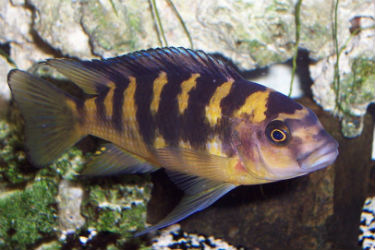 The Amazing Bumblebee Cichlid
The Amazing Bumblebee Cichlid
The first photo I saw of a bumblebee cichlid wasn't really all that impressive. Here was a cute little fish, but it in no way resembled a bumblebee, or any other kind of bee for that matter. It was simple a little black fish. One of the binomial names for this species, Pseudotropheus chameleon, shed some light on the matter. The bumblebee cichlid is capable of changing color, and can become very dark to the point of becoming nearly jet black when angry or feeling aggressive. If you scare or otherwise intimidate this chameleon like fish, it will usually revert to its bumblebee pattern. Juveniles are almost invariably brightly colored, the ability to change colors apparently being something that comes with maturity. The bumblebee cichlid is yellow to yellow orange in color with vertical black stripes, and does indeed bear a resemblance to the bumblebee.
The bumblebee cichlid is also known as the hornet cichlid, and it is a freshwater fish native to Africa, mostly found in the area around Lake Malawi. It is not a particularly large fish, seldom exceeding about 4" in length, although there have been instances in which larger specimens are known to exist.
Breeding - Among cichlids, different species breed in different ways. The bumblebee cichlid is a mouth breeder. The females carry eggs and newly hatched fry in their mouths for two to three weeks. The released fry have had an opportunity to grow to somewhat beyond a microscopic size and have a better chance at survival than those hatching from eggs left in the open. Other cichlid species lay their eggs on rocks or other open spaces, and still others deposit the eggs in more sheltered places. Once a bumblebee cichlid female begins carrying fry about in her mouth, breeders will usually place it in a separate tank. The reason for this is not so much to protect the eggs and fry, but to protect the female from other fish in the tank, as she is less capable of protecting herself. Bumblebee cichlids are considered to be fairly easy breeders, whereas some species of cichlid can be quite difficult to work with in this respect.
Aquarium Considerations - Cichlids are not particularly difficult to care for. Like most tropical fish they need clean, filtered water, typically maintained around room temperature, or a bit warmer. A temperature falling in a range between 75F and 82F is considered best. If the water is too warm, the fish tend to become more aggressive, however warmer temperatures are usually best for fry, as they tend to eat more and develop more rapidly. Cichlids tend to be aggressive fish, or at least the African species are, and are not usually the best choice for a community tank, nor is it always a good choice to have more than one male in a tank. With two or more males in the tank, one will almost invariably attempt to gain dominance. This isn't always a problem, but if a weaker fish attempts to gain dominance there is not always a happy ending. A male together with one or more females usually works out best.
In their native habitats, African cichlids, including the bumblebee cichlid, are used to water that is slightly alkaline, having a pH somewhere between 7.5 to 8.5. If the water in the aquarium gets outside of that range, or the pH level changes too rapidly, the health of the fish could be compromised.
The bumblebee cichlid is an attractive fish, and one that can be entertaining to have, especially when observing their talent for rapidly changing their color patterns.

References


